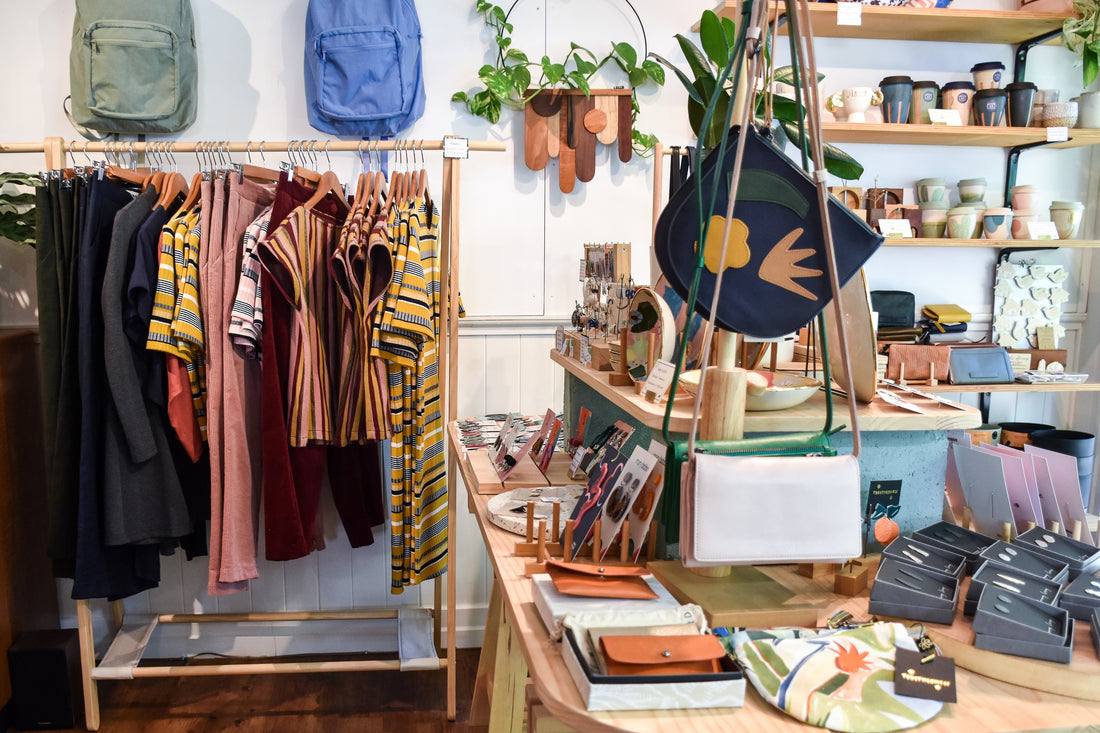
Sustainable Fashion Statistics 2023
Share
In an era of accelerating climate change, rampant overconsumption, and growing social consciousness, sustainable fashion has emerged as more than a trend - it's a necessity. As the environmental and social repercussions of fast fashion become increasingly apparent, consumers, retailers, and designers alike are shifting towards a more sustainable approach to fashion.
This transformation is quantifiable, with numerous statistics reflecting the rapid growth and impact of sustainable fashion.
This article delves into the fascinating realm of sustainable fashion, exploring the key statistics for 2023, providing a comprehensive overview of the industry, and discussing what these numbers mean for the future of fashion.
Sustainable Fashion: Key Trends
As the global consciousness towards sustainability continues to heighten, the sustainable fashion industry has seen a remarkable surge. Here are some key statistics from 2023 that demonstrate the current state and future trajectory of the industry.
1. The global market share of sustainable clothing items is projected to rise to 7.5% by 2026, up from 6.1% in 2022.
2. It is estimated that up to 24 million additional jobs could be created globally by 2040 through the transition to a sustainable textiles industry.
3. About 49% of Gen Z and millennial respondents express their preference for shopping secondhand items.
4. Men between the ages of 25-34 continue to be the leading demographic purchasing sustainable fashion.
Contextualizing These Trends
The projected rise in the global market share of sustainable clothing items to 7.5% by 2026 signals a promising growth in the industry. This steady increase indicates not only the growing popularity of sustainable fashion but also a rising demand for eco-friendly clothing. This trend is beneficial for both the environment and the fashion industry, serving as an impetus for the industry to evolve towards more sustainable practices.
The potential to create up to 24 million jobs globally by 2040 through a transition to sustainable textiles further underscores the socio-economic value of this industry. Not only could this shift reduce environmental impact and increase economic growth, but it could also significantly contribute to poverty reduction and social equality.
Younger generations - particularly Gen Z and millennials - have shown a keen interest in sustainable fashion. Approximately 49% of them have stated their preference for shopping secondhand items. This inclination towards secondhand shopping is a substantial contributor to sustainable fashion since it promotes the recycling and reusing of clothes, thus reducing the demand for new clothing production and subsequently, the associated environmental impact.
In terms of demographics, men aged 25-34 remain the most likely to purchase sustainable fashion. This target demographic's conscious consumerism allows brands to tailor their marketing strategies and product designs to appeal more effectively to these consumers.
Growing Consumer Consciousness for Ethical Fashion, not Just Sustainability
1. The ethical fashion market is expected to burgeon from $9,301.3 million in 2022 to $21,239.5 million in 2032, with an estimated compound annual growth rate (CAGR) of 8.9%.
2. The women's segment has consistently accounted for the largest share of the ethical fashion market, while the men's segment is showing the fastest growth, underlining the increasing interest among males in sustainable fashion.
3. 78% of millennials are now willing to pay more for sustainable brands, highlighting a significant shift in consumer behavior.
4. The apparel industry was responsible for the emission of approximately 1.2 gigatons of carbon dioxide equivalents in 2022, stressing the urgent need for sustainable practices in the fashion industry.
Expanding Ethical Fashion Market
The ethical fashion market is predicted to grow from $9,301.3 million in 2022 to a whopping $21,239.5 million in 2032, indicating a rising demand for ethical and sustainable fashion products. The impressive CAGR of 8.9% is reflective of the global consciousness towards the adoption of eco-friendly practices in the fashion industry.
Gender-Based Segmentation in the Ethical Fashion Market
While the women's segment has traditionally dominated the ethical fashion market, the men's segment is catching up rapidly, proving to be the fastest growing segment in the ethical fashion market. This signifies that the demand for ethical fashion is no longer gender-specific, and men are becoming equally, if not more, inclined towards sustainable choices.
Millennials' Willingness to Pay More for Sustainability
There's been a remarkable shift in consumer behavior, with 78% of millennials stating they're willing to pay extra for sustainable brands. This surge underscores the fact that millennials are consciously considering the environmental impact of their purchases and are willing to invest more in sustainability. This behavior is likely to influence the sustainable fashion industry positively, prompting more brands to align their practices with sustainability.
Carbon Emissions from the Apparel Industry
Carbon emissions from the apparel industry stood at around 1.2 gigatons of carbon dioxide equivalents in 2022, underscoring the pressing need for the industry to switch to sustainable practices. This statistic emphasizes the industry's role in climate change and the urgency to implement drastic changes to mitigate environmental damage.
The Rising Popularity of Secondhand Shopping
With the conscious consumerism wave hitting younger generations, the trend of secondhand shopping has gained significant momentum. About 52% of millennials and Gen Z respondents have shown a propensity to shop secondhand. These numbers are a clear indication of the shifting mindset of these generations towards sustainable practices, playing a significant role in driving the sustainable fashion industry's growth.
Growing Consciousness of the Importance of Sustainability among Fashion Professionals
In a recent survey, an overwhelming 88% of fashion professionals agreed that sustainability is the linchpin for the future of the industry. This overwhelming majority indicates that those at the industry's forefront are acknowledging the importance of sustainable practices, a significant step towards sustainable fashion becoming mainstream.
Increasing Use of Sustainable Raw Materials
Brands have been demonstrating their commitment to sustainability through their sourcing strategies. The use of sustainable raw materials in brand collections increased from 15.8% in 2020 to 45.1% in 2023. This positive trend is a testament to the growing acknowledgement by brands of their environmental footprint and their commitment to reducing it.
Sustainable Alternatives to Synthetic Fibers
Synthetic fibers, which dominated the worldwide textile fiber market in the past, are being increasingly replaced by sustainable alternatives. The growing awareness about synthetic fibers' environmental impact has driven the need for more eco-friendly options, resulting in a shift towards materials like organic cotton and recycled polyester.
Rise of Organic Cotton
The use of organic cotton in sustainable fashion has shown a promising rise. Not only does this alternative significantly reduce blue water consumption by 91%, but it also avoids the use of harmful chemicals that conventional cotton farming often involves. This trend emphasizes the importance of material choices in sustainable fashion and the potential to drastically reduce the industry's environmental impact.
Willingness to Pay More for Sustainable Apparel
The positive trend of consumers willing to pay more for sustainable apparel continues to grow. According to recent statistics, 68% of global consumers are ready to shell out extra for sustainable fashion brands. This statistic underlines that sustainability is becoming a crucial factor in consumer decisions, reminding the fashion industry to prioritize sustainable practices to meet customer needs.
Water Consumption in Apparel Manufacturing
A staggering 2,700 liters of water are required on average to produce a single conventional cotton t-shirt. This fact throws light on the enormous amount of water used in apparel manufacturing and underscores the need for sustainable practices that can significantly reduce water usage.
The Growth of the Sustainable Fashion Industry
As per the latest projections, the sustainable fashion industry is poised to grow at a CAGR of 9.4% from 2023 to 2030. This robust growth rate is a clear indication of the increasing popularity of sustainable fashion and the growing recognition of its importance. It serves as a strong reminder that sustainable fashion is a significant part of the fashion industry and is here to stay.
Wrapping Up
The sustainable fashion industry is experiencing rapid growth and is set to continue its upward trajectory in the foreseeable future. The wealth of sustainable fashion statistics in 2023 underscores this industry's growing relevance in terms of sales, employment, and environmental impact.
With transparency and ethics becoming crucial aspects of the fashion industry, the move towards more sustainable practices seems inevitable. Given the current growth trends and consumer attitudes towards sustainability, it's evident that the sustainable fashion industry is here to stay and poised for continued expansion.
